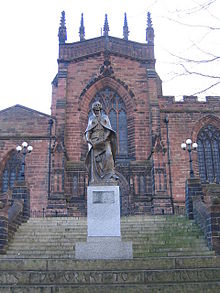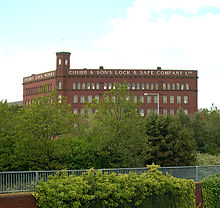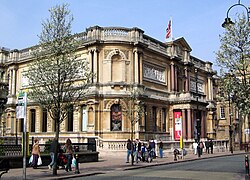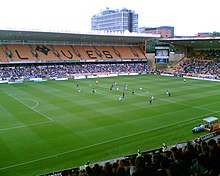Wolverhampton
| City of Wolverhampton | |
|---|---|

| |
| Geography | |
| Status: | Metropolitan borough, City (2000) |
| Region: | West Midlands |
| Ceremonial County: | West Midlands |
| Historic County: | Staffordshire |
| Area: - Total |
Ranked 281st 69.44 km² |
| Admin. HQ: | Wolverhampton |
| ONS code: | 00CW |
| Distance from London: | 131m |
| Demographics | |
| Population: - Total (2022) - Density |
Ranked / km² |
| Ethnicity: | 77.7% White 14.3% Asian 4.7% Black 2.7% Mixed 0.4% Chinese 0.2% Other[1] |
| Politics | |
Wolverhampton City Council http://www.wolverhampton.gov.uk/ | |
| Leadership: | Leader & Cabinet |
| Executive: | |
| MPs: | Rob Marris, Pat McFadden, Ken Purchase |
Wolverhampton is a city in the historic county of Staffordshire and metropolitan county of the West Midlands. In 2004, the local authority area had an estimated population of 239,100;[2] the wider Urban Area had a population of 251,462,[3] which makes it the 13th largest city in England.
The city is commonly recognised as being named after Lady Wulfruna, who founded the town in 985: its name coming from Anglo-Saxon Wulfrūnehēantūn = "Wulfrūn's high or principal enclosure or farm".[4] Alternatively, the city may have earned its original name from a local Danish leader who was called Wulfere.[5] Nevertheless, the name Wulfruna is commonly used in the city - for example, for the Wulfrun Centre or for Wulfrun Hall.
The city's name is often abbreviated to "W'ton"[6] or "Wolves".[7] It is also known as "Wolvo" by many of the locals.[8] The city council's motto is "Out of darkness, cometh light".[9] People from Wolverhampton are known as Wulfrunians.
The city grew initially as a market town with specialism within the woollen trade. During and after the Industrial Revolution, the city became a major industrial centre, with mining (mostly coal, limestone and iron ore) as well as production of steel, japanning, locks, motorcycles and cars - including the first vehicle to hold the Land speed record at over 200mph. Today the major industries within the city are both engineering based (including a large aerospace industry) and within the service sector.[10]
History
Wolverhampton or rather the area between Tettenhall (NW) and Wednesfield (NE) is recorded as being the site of a decisive battle between the Saxons and Danes in 963.[11] The Saxons claimed a decisive victory and the field of Woden is recognised by numerous place names in Wednesfield.[12][13]

A monastery existed in Wolverhampton in Saxon times, founded by Lady Wulfruna and consecrated in 994, for which Wulfruna granted land at Upper Arley in Worcestershire, Bilston, Willenhall, Wednesfield, Pelsall, Ogley Hay near Brownhills, Hilton near Wall, Hatherton, Kinvaston, Hilton near Wolverhampton, and Featherstone. This became the site for the new St. Peter's Church in 1425. A statue of Lady Wulfruna, sculpted by Sir Charles Wheeler, can be seen on the stairs outside the church.
By the 13th century Wolverhampton had grown to become a thriving market town. The city was famous for its part in the woolen trade, a fact that can be seen by the inclusion of a woolpack on the city's coat of arms, and by the many small streets, especially in the city centre, called "Fold" (examples being Blossom's Fold, Farmers Fold, Townwell Fold and Victoria Fold), as well as Woolpack Street.
From the 16th century onwards, Wolverhampton became home to a number of metal industries including lock and key making and iron and brass working. In 1512, Sir Stephen Jenyns, a former Lord Mayor of London, who was born in the city founded Wolverhampton Grammar School, one of the oldest active schools in Britain.
In January 1606, two farmers, Thomas Smart and John Holyhead of Rowley Regis, were hanged in High Green, now Queen Square, for sheltering some of the Gunpowder Plotters who had fled to the Midlands. The pair played no part in the original plot but nevertheless suffered the traitor's death of being hanged, drawn and quartered on butcher's blocks set up in the square a few days before the execution of Guy Fawkes and several other plotters in London.
In the 19th century the area to the south-east of the city became known as the Black Country because of the heavy industrial pollution which covered the area in black soot. In Victorian times, Wolverhampton grew to be a wealthy town mainly due to the huge amount of industry that occurred as a result of the abundance of coal and iron deposits in the area. The remains of this wealth can be seen in local houses such as Wightwick Manor and The Mount (both built for the Mander family, prominent varnish and paint manufacturers), and Tettenhall Towers. Many other houses of similar stature were built only to be demolished in the 1960s and 1970s. In the 19th century the city saw much immigration from Wales and Ireland; in the 20th and 21st centuries immigrants have come from places further afield, such as the Caribbean, South Asia, Africa and eastern Europe.
Wolverhampton was incorporated as a municipal borough in 1849 under the Municipal Corporations Act 1835.
In 1866, a statue was erected in memory of Prince Albert, the unveiling of which brought Queen Victoria to Wolverhampton.[1] The unveiling of the statue was the first public appearance Queen Victoria had made since the funeral of her husband the Prince Consort. A 40 foot tall archway made of coal was constructed for the visit. The Queen was so pleased with the statue that she knighted the then mayor, an industrialist named John Morris. Market Square, originally named High Green, was renamed Queen Square in honour of the visit. The statue replaced a Russian cannon captured from Sevastopol during the Crimean War in 1855, and remains standing in Queen Square.

England's first automatic traffic lights could be seen in Princes Square, Wolverhampton in 1927. The modern traffic lights at this location have the traditional striped poles to commemorate this fact.
The railways reached Wolverhampton in 1837, with the first station located at Wednesfield Heath, now Heath Town. This station was demolished in 1965, but the area exists as a nature reserve just off Powell Street. Wolverhampton Railway Works was established in 1849 for the Shrewsbury and Birmingham Railway and became the Northern Division workshop of the Great Western Railway in 1854.
Wolverhampton High Level station (the current main railway station) opened in 1852, but the original station was demolished in 1965 and then rebuilt. Wolverhampton Low Level station opened on the Great Western Railway in 1855. The site of the Low Level station, which closed to passengers in 1972 and completely in 1981, is currently undergoing redevelopment. Wolverhampton St George's (in the city centre) is now the northern terminus for the Midland Metro light rail system. Wolverhampton was one of the few towns to operate surface contact trams and the only town to use the Lorain Surface Contact System. Trolleybuses appeared in 1923 and in 1930 for a brief period, Wolverhampton was the world's largest trolleybus system. The last trolleybus ran in 1967, just as the railway line through the High Level station was converted to electric operation.
Wolverhampton was represented politically in Victorian times by the Liberal MP Charles Pelham Villiers, a noted free trade supporter, who was also the longest serving MP in parliamentary history. Lord Wolverhampton, Henry Hartley Fowler was MP for Wolverhampton at the turn of the century. Sir Geoffrey Le Mesurier Mander, a member of the Mander family, was Liberal MP for Wolverhampton East from 1929 to 1945, distinguished for his stance against Appeasement and as a supporter of the League of Nations; known as "the last of the Midland radicals". More recent members have included the Conservative mavericks Enoch Powell and Nicholas Budgen. Recently former Bilston councillor and MP for Wolverhampton South East, Dennis Turner entered the House of Lords as Lord Turner of Bilston.
The United Kingdom government announced on December 18, 2000 that Wolverhampton would be granted city status, making it one of three "Millennium Cities".[14]
Governance
The vast majority of Wolverhampton is governed locally by Wolverhampton City Council, although some small areas are governed by South Staffordshire District Council.
The area administered by the City Council is represented in the national United Kingdom parliament by three MPs representing Wolverhampton South West, Wolverhampton South East and Wolverhampton North East constituencies, with the areas administered by South Staffordshire District Council being represented by South Staffordshire constituency. The entire city is part of the West Midlands constituency of the European Parliament.
Since the abolition of West Midlands County Council in 1986, Wolverhampton City Council has been effectively a unitary authority. South Staffordshire District Council is a two-tier authority, with some services provided by Staffordshire County Council.
Civic history
Wolverhampton gained the beginnings of modern local government in 1777, when the Wolverhampton Improvement Act was passed by Parliament. This allowed for the establishment of 125 Town Commissioners who undertook a variety of local improvement work such as punishing bear baiting, improving drainage, widening streets and by the end of the century street lighting had been provided in the at every street corner and over the doorway of every inn, and water supply had been improved by the sinking of ten new wells and the provision of a great water tank in the market place. Policing had been improved with the appointment of ten watchmen and attempts were also made to regulate the markets and inspect hazardous food.[15][16]
Wolverhampton parliamentary borough was created by the Reform Act 1832, which included areas currently located with the Metropolitan Boroughs of Dudley, Walsall and Sandwell such as Wren's Nest, New Invention and Gornal. It initially returned two Members of Parliament.
Wolverhampton was incorporated as a municipal borough in 1849 under the Municipal Corporations Act 1835, and at the same time Wolverhampton Borough Police was formed. The town was then made a County Borough in 1889 under the Local Government Act 1888.
In 1933, the boundaries of the borough expanded, taking in areas from Cannock Rural District and Seisdon Rural District, with very little of the surrounding urban area being affected,[17] with only Heath Town Urban District being abolished.
The bulk of the formerly independent urban districts of Bilston (a borough itself after 1933), Tettenhall and Wednesfield were added to the borough in 1966,[18] along with part of the urban district of Coseley and small parts from Sedgley and Willenhall. At the same time Wolverhampton Borough Police was disestablished and the larger West Midlands Constabulary, which covered not only Wolverhampton but the County Boroughs of Walsall, Dudley, West Bromwich and Warley took over its duties and was headquartered in the city.
Wolverhampton was one of only two County Boroughs (the other being Liverpool) to have no changes made to the boundary during the 1974 reorganisation of local government, the borough already having a population larger than the 250,000 required for education authorities. This contrasted with both the Redcliffe-Maud Report, and the initial White Paper for the 1974 reforms[19] where large areas of the present South Staffordshire district were to be added to the borough. During the 1974 reforms it was placed within the West Midlands Metropolitan County.
Wolverhampton was also a Royal Peculiar covering a large area.
Wards of the City Council
The following is a list of the 20 wards of Wolverhampton City Council:
A map showing the ward boundaries is available here. GeographyWolverhampton lies northwest of its larger near-neighbour Birmingham, and forms the second largest part of the West Midlands conurbation. To the north and west lies the Staffordshire and Shropshire countryside. Wolverhampton city centre falls outside of the area traditionally known as the Black Country, although some districts such as Bilston and Heath Town fall within the Black Country coalfields, leading to confusion as to whether the entire city falls within the region. Modern usage has tended towards using the term to refer to the western part of the West Midlands county, excluding Birmingham, Solihull and Coventry. Examples would be UK Government regional bodies such as "The Black Country Development Corporation", under whose remit the city fell. The city lies upon the Midland Plateau at approximately 120m above sea level.[20] There are no major rivers within the city, although the River Penk and River Tame (tributaries of the River Trent) rise in the city, as does Smestow Brook, a tributary of the River Stour, and thence the River Severn. This means that the city lies astride one of the major drainage divides of England. The geology of the city is complex, with a combination of Triassic and Carboniferous geology; specifically Bunter and Keuper sandstone, and Upper and Middle Coal measures. There is also an area of dolerite deposits.[21] ClimateWolverhampton's climate is quite temperate with average maximum temperatures in July being around 21°C (70°F) with the minimum daytime temperature in January being around 6.5°C (44°F). The Met Office's nearest observation station is at Penkridge, about 5 miles north of the city.
Areas of the cityLocalities in the City of Wolverhampton include:
|
|||||||||||||||||||||||||||||||||||||||||||||||||||||||||||||||||||||||||||||||||||||||||||||||||||||||||||||||||||||||||||||||||||||||||








